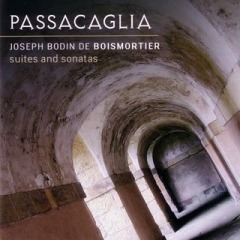J.B. de Boismortier – Suites and Sonatas (2003)
J.B. de Boismortier – Suites and Sonatas (2003)

Trio Sonata in G major
1.Preludio (Grave) 01:51
2. Allemanda (Allegro) 02:21
3. Affettuoso 01:28
4. Giga (Allegro) 02:00
Sonata in D major
5. Sicilienne 02:48
6. Gayement 02:09
7. Gracieusement 01:54
8. Gayement 03:25
Cinquième Suite in D minor
9. Prélude 03:39
10. Bourée en Rondeau 01:05
11. Rondeau Gracieusement 02:36 play
12. Allemande (Gayement) 02:15
13. Gigue 01:39
Trio Sonata in E minor
14. Legerement 02:15
15. Rondeau Gracieusement 02:36
16. Allemande (Gayement) 02:15
17. Lentement 01:23
18. Gigue 01:39
Suite in A major
19. La Veloutée 02:01
20. L'Indeterninée 01:55
21. La Frenetique 01:58
22. La Brunette 05:31
Sonata in E minor
23. Allegro 01:49
24. Allemanda (Allegro) 02:19
25. Adagio 01:36
26. Giga 01:11
Diverse Pieces de Violes in C
27. Prelude (Lentement) 01:46
28. Allemande 02:17
29. Siciliene en Rondeau 02:44 play
Gentilesse in G major
30. Gaiment 02:26
31. Gracieusement 01:35
32. Gaiment 02:46
Passacaglia:
Annabel Knight (flutes)
Louise Bradbury (recorders)
Robin Bigwood (harpsichord)
Reiko Ichise (viola da gamba)
Eligio Quinteiro (lutes)
Few eighteenth-century composers earned a personal fortune solely by writing music; Joseph Bodin de Boismortier did, and could claim to be the first Frenchman to sell his talents on the open market. By 1700, the spread of music printing and publishing in Europe, allied to the growth of amateur music-making, made substantial sales of new music possible, and Boismortier seized every opportunity for meeting the popular demand for tuneful, technically simple pieces for a wide variety of vocal and instrumental combinations.
Within a year of arriving in Paris in 1723, his first publications were on sale, and by 1747 had been followed by 102 works. This readiness to provide what the public wanted brought financial success and popularity, but a certain amount of envious comment from the French cultural establishment as well: composers were not supposed to be businessmen! In his Essay on Music, Early and Modern (1750) Jean-Benjamin de La Borde, a contemporary of Boismortier, commented Boismortier ability to turn composition into a lucrative enterprise. The composer's response to La Borde's remarks was brief and to the point: "I make money".
Following common practice of the time, Boismortier frequently scored for alternative instruments—for example,. recorder, flute, oboe or violin—thus increasing his sales potential. He was particularly industrious in writing for the flute, and also published a flute method. So fashionable was the instrument in France that the mere imprint "suitable for flute" virtually guaranteed a publishing success. Rustic instruments, such as the musette (bagpipes) and vielle (hurdy-gurdy), were also in vogue, and Boismortier swiftly obliged by providing them with something easy to play.
His output encompassed secular cantatas, motets, songs and four stage works, including an opera, Daphnis et Chloé. He was also an innovator. As the first French composer to adopt the Italian title concerto, he wrote the first French solo concerto for any instrument (in this case the 'cello), as well as a large number of flute sonatas and a set of unaccompanied concertos for three, four, and five flutes.
Boismortier was extremely prolific, but much of what he wrote, though pleasant enough, could hardly be considered significant. At its best it is tuneful, elegant, and by no means naïve. In his Essay on Music, La Borde wrote: "Although [his works] have long been forgotten anyone who desires to take the trouble to excavate them will find enough grains of gold dust there to make an ingot." Today he might have been less grudging, since many of Boismortier's works are still being published, and continue to appeal to players of both modern and period instruments. --Roy Brewer, All Music Guide
download: uploaded anonfiles mega 4shared mixturecloud yandex mediafire ziddu
Zmieniony (Środa, 11 Wrzesień 2013 13:33)








